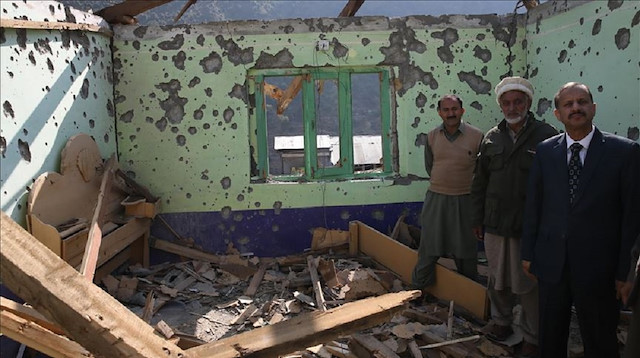
There is no war, but it is no less than war, say residents, as Anadolu Agency travels remote border area on Pakistan side
The scenic Jura town in Neelum Valley of Pakistan-administered Kashmir should have been a cynosure of tourists and nature lovers.
But, its 20,000 inhabitants are living in fear and despair, as Indian and Pakistani troops are continuously exchanging fire, along the Line of Control (LoC) -- the de facto border, dividing the state of Jammu and Kashmir.
Earlier in the times of tensions, the troops would exchange small arms fire, but after Aug 5, when India revoked special status of the region, both sides have moved heavy artillery to forward positions, pumping mortars and shells, which often fall in the villages, on both sides of the dividing line.
As Anadolu Agency traveled along the LoC visiting villages of Jura, Shahkot and Nousehri, on the banks of the gushing waters of Neelam River also known as Kishanganga, one could notice that life has been thrown haywire on both sides. Instead of harvesting ripe crops, people are busy, building bunkers and trenches to save their lives. Shops and walls are scorched black.
Adding to their misery, toy bombs dropped in the villages pose an immediate threat to children. While New Delhi denies dropping toy bombs, locals say they have seen such explosives on the roadside facing Indian positions.
Last month one child was killed and three others wounded when the child touched a toy lying on the roadside in Chilan area, a village in the Nousehri sector. The toy immediately exploded in his hand, say local people.
“We have requested people, whenever they see any toy on the road, avoid touching and inform the police or the nearest army picket," Raja Mahmood Shahid, executive head of the Neelum district, told Anadolu Agency.
One could see pieces of metal and piles of the remnants of Indian shelling, dotting the single road, connecting these villages to the external world. An unusual calm prevails on the other side of the LoC as well. Heavily fortified Indian posts are visible from a distance. The villages on their sides also look empty.
"When the shelling starts, we rush in the makeshift basements of our home," Rashid, 58, businessman and a local political activist told Anadolu Agency.
His own house stands completely destroyed. "This was our family house, which I was sharing with two brothers," he said, pointing towards the debris.
The shells had landed at the local high school building as well, completely destroying it.
"There were no students in the building as the school was bombed at night. But all the records and furniture were completely destroyed,” said Khawaja Mansha, a local education officer, pointing towards the gutted building. "There is no war here, but we are living in a war-like zone."
Mortars have also damaged several shops and a bank.
"I have lost my business worth 5,000,000 Pakistani rupees ($32,200) and now have no savings to restart my business," said Pir Zada Qasim Shah, who owned a furniture shop in the main market.
Another house that was completely destroyed was owned by Mir Imtiaz, 52, a laborer.
"I am very poor and working in the local market as a laborer, barely covering the daily expenses of my wife and five children,” he said.
According to the local administration, 165 houses, 38 shops, three schools and 15 vehicles were damaged during the Oct. 20 Indian shelling.
"The government has provided one million rupees ($6,400) per head as compensation to the victims’ families and a half million rupees ($3,200) to each of the injured," said Raja Shahid.
Most people have built small bunkers in their homes, which help them to save their lives.
"The government is constructing community bunkers for local people to protect them from Indian shelling. So far, we have built around 20 bunkers," said Shahid.
Soon after the attack on Oct. 20, Indian Army Chief General Bipin Rawat claimed that his forced had hit three terrorist launchpads in the town of Jura, killing scores of terrorists, including some military personnel.
In November 2003, India and Pakistan agreed to a ceasefire, after one-and-half year military standoff, following a terrorist attack on Indian parliament in December 2001. But they failed to set up a monitoring mechanism.
According to the Pakistani Army, since February of this year, the Indian Army has committed 2,229 ceasefire violations, killed 42 civilians and injured 169 others. India’s Ministry of External Affairs claims that there has been a total of 2,050 ceasefire violations from Pakistan side, in 2019 in which, 21 civilians lost their lives.
In 1948, the UN Security Council had posted a UN Military Observer Group in India and Pakistan (UNMOGIP) to investigate ceasefire violation complaints and to report them to the UN in New York. But the 114 strong UNMOGIP staff cannot independently visit the LoC on the Pakistani side.
More so, India no longer accepts their mandate. India believes that their mandate has expired in 1972 after the Simla Agreement, when both sides mentioned Kashmir as a bilateral dispute. The UNMOGIP has offices in Srinagar, Muzaffarabad, Rawalpindi and New Delhi.


